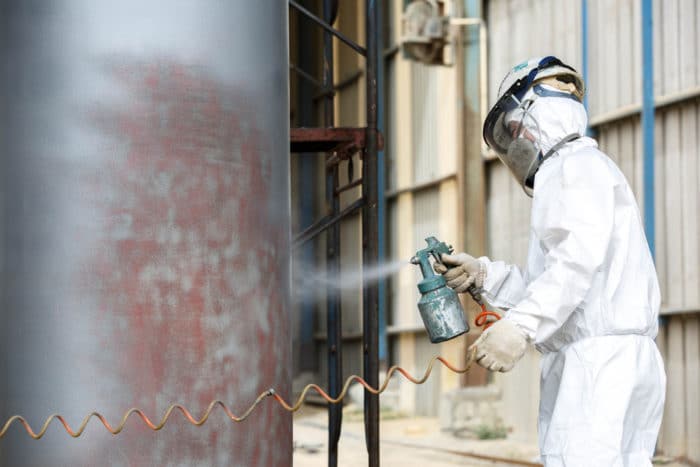Why We Love It
-
$33,610Potential Avg. Salary
-
-0.7%Job Growth Rate
-
Dependable Daily WorkloadCareer Attribute
-
Don't Take Work HomeCareer Attribute
Industrial painters and sprayers are high in demand on both sides of the Atlantic Ocean and indeed across the globe. While the requirements for painters and spray painters in traditional manufacturing industries is high already, it has come to be of considerably high demand in associated new industries such as space agencies, where paints play a very important role in protecting the structures from the high heat of air resistance and in thruster portions generated from the engine.
Recommended Schools
What is an Industrial Painter and Sprayer?
Duties of an industrial painter and sprayer include the following.
- Ensuring uniform application of paint coating on the surface of the metal is important. Because, non-uniform junctures can easily become easy spots for corrosion due to differential exposure the metal will receive and the resulting difference in percolation of moisture.
- Many a times there is demand for industrial painters to paint the inner sections of the industrial buildings. This requires careful study of the manufacturing process to be conducted within and the kind of chemical vapours and temperature and fumes that will be produced within will have to be studied as there as is chance of them reacting with the paint coating.
- Before application of paints ensuring the surface is smoothened and cleaned so as not to capture any dust or particulate matter in the coating.
- Spraying involves using high tech machinery, the calibration of which the industrial painter and sprayer is required to be familiar with.
- Sometimes older paint coatings might need to be removed.
- Blasting techniques are an additional skillset which involves blasting powdered abrasives onto a surface at high speed to make the micro-abrasions to make the surface ultra-smooth before painting.
- Assessing which base is to be used for the paint to ensure maximum adhesion to the surface based on the material and texture.
Day in the life
A day in the life of an industrial painter and sprayer revolves around the duties mentioned above. A duty log is created to assess priority of articles that need to be painted. As much the urgency of a finished good, there are several other factors that go into evaluating which article needs to be painted when. Each base oil of a paint has different timing for drying. Adherence is also dependant on the material. And many a times more than one coating is required either for protection or to bring out the desired hue. Accordingly the painting of articles is to be planned taking the intermittent stages of painting and drying and reapplication into account.
One gets to interact with multiple teams and even has to interact with the design team for providing feedback and with the delivery team to determine on delivery timing. It is a highly skilled job which gets a lot say in the shop floor as it is a very important step in the manufacturing process. Most auto companies have a separate building designated for painting.
Work schedule and typical hours
Work schedules are fixed and are the eight hours is the norm in most industries. The work is not seasonal, so similar work hours are expected throughout the year.
Growth of the job
It is a niche skilled job that is high in demand across industries. Also salary is determined by the industry that one works in. For instance, working in defence armament factories with specialised paints obviously leads to much higher salary.
Apart from painting and spraying there is also a huge overlap with the requirement for those who are also proficient with blasting to remove non uniform protrusions on surfaces of the final goods. Additional specialisations such as this lead to higher pay packages besides getting more opportunity for employment for beginners.
Typical employers
Being an industrial painter or sprayer open up avenues in a wide range of industries. These include automobile companies, steel sheet manufacturing companies, shipyards, defence factories, Plumbing and tubing equipment, body shops. The list is endless.
Recommended Schools
How To Become an Industrial Painter and Sprayer
Across the globe demand for this job can be found online easily and can also be applied to easily. One can also register oneself as a freelancer, available for short project duration of three or six months on several portals. At the bare minimum, a High school diploma is required. Professional courses are available for painters and sprayers too. There are various online sources with detailed procedure on how to attend these courses and the best places to be trained from.
Industrial Painter and Sprayer Salary Data
We’ve provided you the following to learn more about this career. The salary and growth data on this page comes from recently published Bureau of Labor Statistics data while the recommendations and editorial content are based on our research.
National Anual Salary
Low Range
$25,740Average
$33,610High Range
$48,580National Hourly Wage
Low Range
$12/hrAverage
$16/hrHigh Range
$23/hrHow do Industrial Painter and Sprayer salaries stack up to other jobs across the country? Based on the latest jobs data nationwide, Industrial Painter and Sprayer's can make an average annual salary of $33,610, or $16 per hour. This makes it an Above Average Salary. On the lower end, they can make $25,740 or $12 per hour, perhaps when just starting out or based on the state you live in.
Salary Rankings And Facts
#643 Nationally for All Careers
Highest Education Among Industrial Painter and Sprayers
- 0% Doctorate
- 0.2% Masters
- 3.7% Bachelors
- 5.7% Associates
- 21.4% College
- 45.7% High School
- 23.2% Less than High School
Job Growth Projections and Forecast
2014 Total Jobs
97,7002024 Est. Jobs
97,000Job Growth Rate
-0.7%Est. New Jobs
-700How does Industrial Painter and Sprayer job growth stack up to other jobs across the country? By 2024, there will be a change of -700 jobs for a total of 97,000 people employed in the career nationwide. This is a -0.7% change in growth over the next ten years, giving the career a growth rate nationwide of Below Average.
Growth Rankings And Facts
#633 Nationally for All Careers
What Companies Employ The Most Industrial Painter and Sprayers
| Industry | Current Jobs | New Jobs Needed | % Increase |
|---|---|---|---|
| Coating, engraving, heat treating, and allied activities | 16,500 | 1,000 | 1% |
| Architectural and structural metals manufacturing | 6,600 | 400 | 0% |
| Self-employed workers | 6,100 | 500 | 1% |











